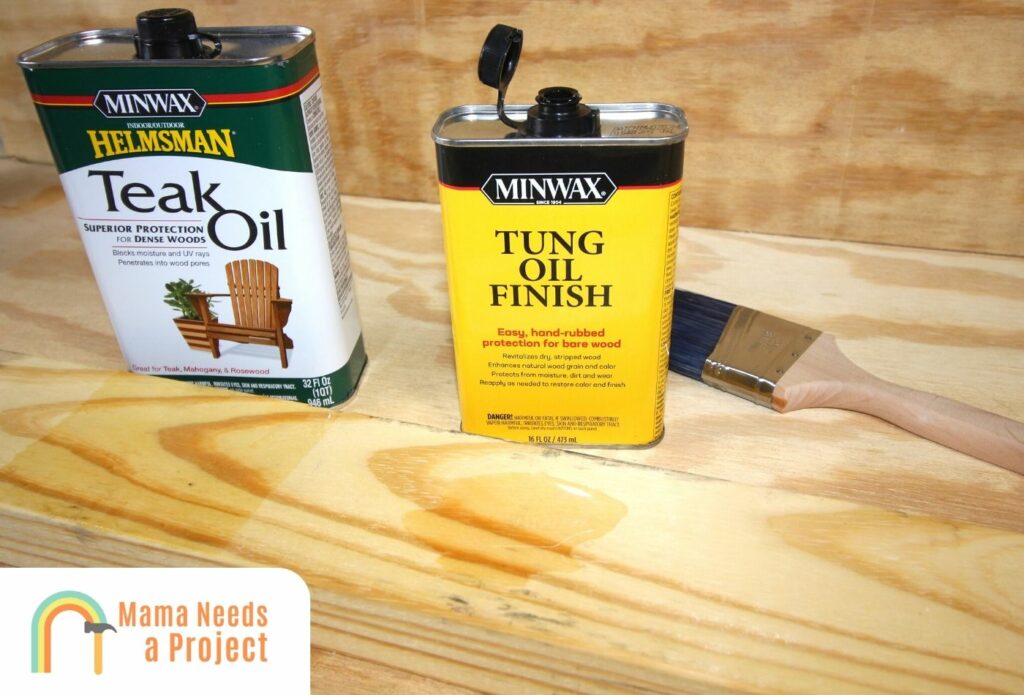How Many Coats of Tung Oil? (Tips & Tricks)
If you’re completing a wood project – there are many different finishes you could apply. One of my favorites is tung oil.
But how many coats of tung oil should you apply?
In this article, I’ll discuss how many coats of tung oil should be used for different kinds of wood surfaces, and I’ll also cover a lot of important info that you can use to ensure you put down a beautiful and durable tung oil finish. Let’s begin!
- 5 coats of pure tung oil is enough for most wood surfaces, but exterior surfaces can benefit from getting a coat or two more while interior surfaces rarely need 5 coats—usually 3’s enough.
- Softwoods need more coats because they’re more porous, and larger surfaces need more coats to ensure an effective overall finish.
How Many Coats of Tung Oil Should I Apply?
How much tung oil a surface needs is determined by a range of factors, such as the material, the amount of tung oil used, and the size of the surface.
Generally speaking, however, it usually takes 4-5 coats to form an effective, eye-catching finish on most wood surfaces.
Outdoor Surfaces
Because they’re exposed to the elements (rain, wind, sunlight, pests) routinely, outdoor wood surfaces require more tung oil.
Depending on what the surface is, it may be necessary to use as many as 7 coats.
For example, a picnic table would need 5-7 coats of tung oil finish.
Wood furniture that’s under an awning or balcony won’t be as exposed, and therefore 5 coats should do.
Tung oil is a good wood oil for outdoor surfaces because it’s quite water resistant, it doesn’t fade in the sun, and naturally repels pests.
Interior Surfaces
Tung oil is great for exterior surfaces and interior surfaces alike, and inside it’s especially useful since it’s food-safe, just like polyurethane. This is why it’s used to coat cutting boards and butcher’s blocks, as well as wooden bowls, plates, and cutlery.
It’s also a fantastic natural oil finish for kitchen and bathroom cabinets since it’s waterproof yet accentuating.
For interior surfaces, 3 coats of tung oil should get the job done.
Everyday Furniture
Everyday furniture, i.e. chairs, tables, desks, couches, and ottomans, should get many coats of tung oil (5-7) because these pieces are more at risk of getting damaged.
And even if used properly, frequent use speeds up wear and tear, unless a tung oil coating is there to slow this process substantially.
Fine Furniture & Antiques
Tung oil and other natural oils highlight fine furniture and antique wooden objects much better than polyurethane and similar finishes.
For these pieces, usually only a few coats (1-3) are needed to highlight the wood’s rich, natural colors and its unique grain patterns.
What Happens if You Don’t Apply Enough Coats?

Less Protection
Granted, tung oil—whether it’s pure tung oil or polymerized tung oil—isn’t the most durable wood finish, but it’s still strong enough to protect outdoor wood furniture and structures from the elements year round.
So to maximize tung oil’s effectiveness as a protective natural wood oil, apply more coats than less and simply remove any excess oil that presents.
Tung oil won’t leave a glossy finish, which is one of the main reasons why you can get away with applying so many coats.
Less Visual Appeal
Applying an insufficient number of tung oil coats won’t discolor the surface, but it’ll fail to bring out the wood’s naturally eye-catching qualities.
Darker hardwoods, for example, need at least three coats of tung oil for their grain patterns and shades to be highlighted.
Especially porous surfaces, i.e. most softwoods, need more tung oil because it quickly and easily seeps into wood pores before drying into a hardened finish.
How Long for Tung Oil to Dry Between Coats
After you apply the first coat of tung oil, you should allow for 8-12 hours of drying time.
If you want to be on the safe side wait 24 hours before applying the second coat, but be aware that waiting this long between coats can significantly elongate some projects and is rarely necessary.
Obviously, the more oil you apply per coat, the longer the overall drying process will be.
Tung oil dries faster when the temperature is between 70°F-80°F and there’s little humidity.
Decent air circulation and direct sunlight can also speed up the process, but be careful when using the latter, as too much sunlight could cause the finish to dry incorrectly.
Looking for how many coats of other wood finishes? Check out this guide to learn how many coats of lacquer or this guide to learn how many coats of polyurethane you should use!
What Affects Tung Oil Drying Time?
Temperature & Humidity
In 70-80°F weather, when there’s 30-50% humidity, tung oil should be completely dry 8-12 hours after it’s applied.
When it’s too hot or too cold, or when there’s especially high humidity, tung oil takes longer to dry and may not ever dry properly.
Amount of Oil Used
Like with other oil finishes, if an excessive amount if oil is applied to a wood surface, the drying process will be elongated, and it’s more likely than not the surface will never reach complete dryness.
Fortunately, tung oil is wiped on with a clean cloth, so it’s easier to avoid over-applying.
But if you’re using a natural-bristle brush—and some woodworkers do—be particularly mindful of how much tung oil you’re applying until the project is complete.
Surface Material
Generally, hardwoods that have been coated with pure tung oil dry quicker than softwoods coated with the same finish, and this is mainly because hardwoods are denser and require less oil.
Size of Surface
It goes without saying, but a large surface that’s been coated with tung oil will take longer to dry than a smaller surface, and there are a handful of reasons for this that I’ll discuss in another post.
How to Apply Tung Oil Coats
1. Gather Supplies
First, gather all the materials you’ll need. Specifically, you’ll need:
- Tung oil
- Mineral spirits
- Fine-grit sandpaper or steel wool
- 2-3 clean cotton cloths
You may find that other materials not listed above help with tung oil application; the materials above are just the essentials.
2. Prep Surface
Next, you need to get the wood surface prepped for the tung oil.
First, clean it off with mineral spirits (or warm soapy water if you don’t want to use something harsh).
Once the surface has had several hours to dry, rough it up with some fine-grit sandpaper or steel wool; doing so will help the tung oil soak into the wood pores.
Focus on light sanding and be careful not to take off too much material.
Once you’re done sanding, remove the fine white dust that’s been created with a vacuum or tack cloth.
3. Apply Finish
After the wood surface has been properly prepped, it’s ready for tung oil.
Don’t soak your cloth in oil. If you do, you’ll be more prone to applying too much; this can also make a big mess.
A palm-size area on the cloth should be enough.
When wiping tung oil on a flat surface, use your fingertips to apply a bit of pressure; this way the oil can penetrate the wood better.
If you’re wiping oil on a chair leg or something similar, wrap the cloth around the surface and wipe up and down, twisting both clockwise and counterclockwise as you do.
4. Allow it to Dry
When you’re finished applying the first coat, wait 8-12 hours before applying the second coat.
Once all the coats have been applied, it’ll be 3-5 days before the full tung oil finish is completely cured.
Check out this tung oil vs linseed oil to understand which you should use!
How to Tell if Another Coat of Tung Oil Is Needed
Unlike other oils, tung oil gives a sneak preview of how it’s going to look once fully dry before it’s even close to reaching this state, which means you don’t have to use extra oil on a throwaway workpiece beforehand to gauge how the tung oil finish is going to look once dry.
Final Thoughts
To recap, 5 coats of tung oil will do in most instances.
But if the surface is more prone to damage and accelerated wear and tear, 7 coats should do.
On the other hand, fine wood furniture and antiques that’ll rarely be in harm’s way should get 3 coats.
Adding more coats does strengthen the overall finish, but after about three coats the oil will reach the limits of its feature-accentuating capability.

